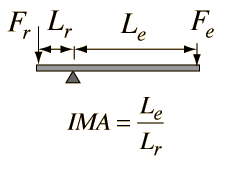
Background on Simple Machines:
A machine is a device that does work. Most machines consist of a number of elements, such as gears and ball bearings, that work together in a complex way. Nonetheless, no matter how complex they are, all machines are based in some way on six types of simple machines. These six types of machines are the lever, the wheel and axle, the pulley, the inclined plane, the wedge, and the screw.
Principles of Simple Machines:
Machines simply transmit mechanical work from one part of a device to another part. A machine produces force and controls the direction and the motion of force, but it cannot create energy. A machine's ability to do work is measured by two factors. These are (1) mechanical advantage and (2) efficiency.
Mechanical advantage. In machines that transmit only mechanical energy, the ratio of the force exerted by the machine to the force applied to the machine is known as mechanical advantage. Under mechanical advantage the distance the load will be moved will be only be a fraction of the distance through which the effort is applied. While machines can provide a mechanical advantage of greater than 1.0 (and even less than 1.0 if desired), no machine can never do more mechanical work than the mechanical work put into it.
Efficiency. The efficiency of a machine is the ratio between the work it supplies and the work put into it. Although friction can be decreased by oiling any sliding or rotating parts, all machines produce some friction. A lever has a high efficiency due to the fact that it has low internal resistance. The work it puts out is almost equal to the work it receives, because energy used up by friction is quite small. On the other hand, an a pulley might be relatively inefficient due to a considerably greater amount of internal friction. Simple machines always have efficiencies of less than 1.0 due to internal friction.
Energy conservation. Ignoring for a moment the losses of energy due to friction, the work done on a simple machine is the same as the work done by the machine to perform some sort of task. If work in equals work out, then the machine is 100% efficient.
Lever. A lever is a bar resting on a pivot. Force (effort) applied at one point is transmitted across the pivot (fulcrum) to another point which moves an object (load).

The ideal mechanical advantage (IMA) - ignoring internal friction - of a lever depends on the ratio of the length of the lever arm where the force is applied divided by the length of the lever are that lifts the load. The IMA of a lever can be less than or greater than 1 depending on the class of the lever. There are three classes of levers, depending on the relative positions of the effort is applied, load, and fulcrum.
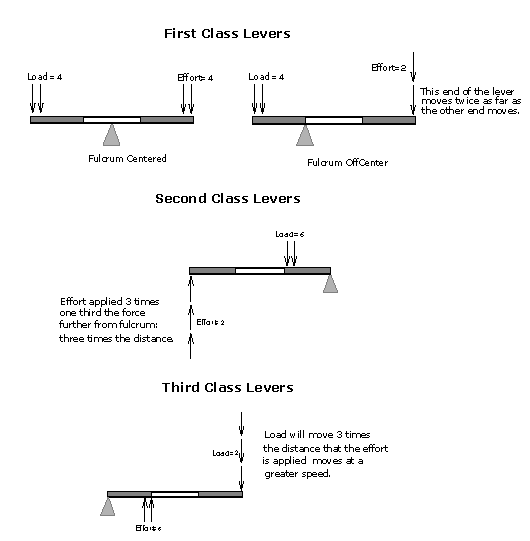
Wheel and axle. The wheel and axle is essentially a modified lever, but it can move a load farther than a lever can. The center of the axle serves as a fulcrum.

The ideal mechanical advantage (IMA) of a wheel and axle is the ratio of the radii. If the effort is applied to the large radius, the mechanical advantage is R/r which will be more than one; if the effort is applied to the small radius, the mechanical advantage is still R/r, but it will be less than 1.
Pulley. A pulley is a wheel over which a rope or belt is passed. It is also a form of the wheel and axle. Pulleys are often interconnected in order to obtain considerable mechanical advantage.
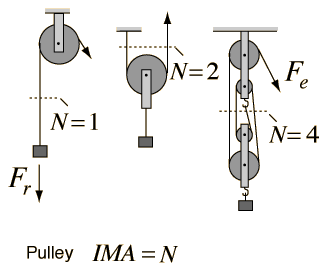
The ideal mechanical advantage (IMA) of a pulley is directly dependent upon the number of support strings, N.
Inclined plane. The inclined plane is a simple device that hardly looks like a machine at all. The mechanical advantage increases as the slope of the incline decreases. But the load will then have to be moved a greater distance.
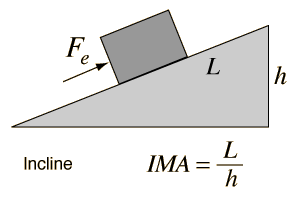
The ideal mechanical advantage (IMA) of an inclined plane is the length of the incline divided by the vertical rise, the so-called run-to-rise ratio. The mechanical advantage increases as the slope of the incline decreases, but then the load will have to be moved a greater distance. Again, work in equals work out in an entirely efficient system. Friction will be large if objects are slide along the surface of the inclined plane. Efficiency can be increase by using rollers in conjunction with the inclined plane.
Wedge. The wedge is an adaptation of the inclined plane. It can be used to raise a heavy load over a short distance or to split a log.
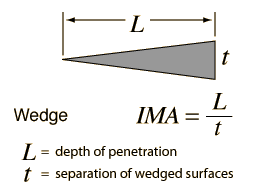
The ideal mechanical advantage (IMA) of a wedge depends on the angle of the thin end. The smaller the angle, the less the force required to move the wedge a given distance through, say, a log. At the same time, the amount of splitting is decreased with smaller angles.
Screw. The screw is actually an inclined plane wrapped in a spiral around a shaft. A jackscrew combines the usefulness of the screw and the lever. The lever is used to turn the screw.
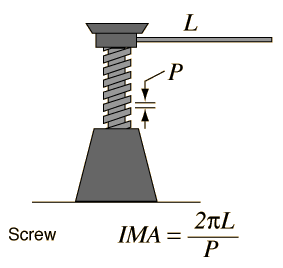
The ideal mechanical advantage (IMA) of a screw is ideally the ratio of the circumference of the screw to the distance it advances during each revolution. Machine screws, working their way through a nut, can be relatively efficient. Wood screws tend to be anything but 100% efficient as considerable amounts of energy are lost to friction and the displacement of matter. A jackscrew, such as those used to raise homes and other structures, combines the usefulness of the screw and the lever. The lever is used to turn the screw. The mechanical advantage of a jackscrew is quite high.